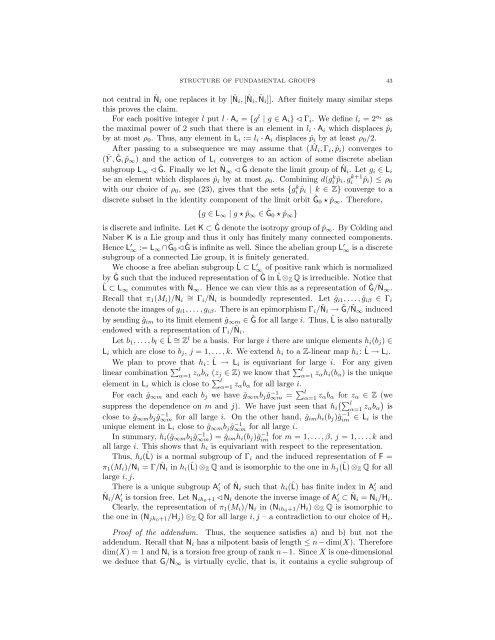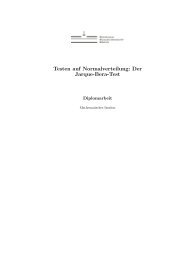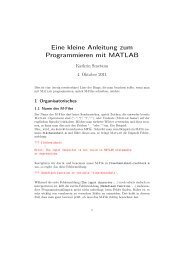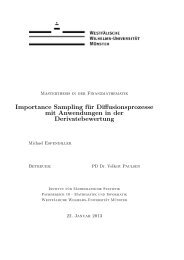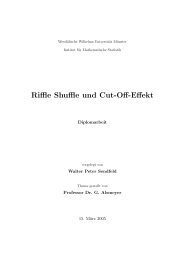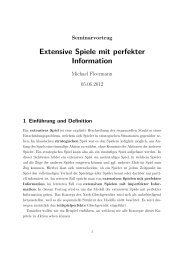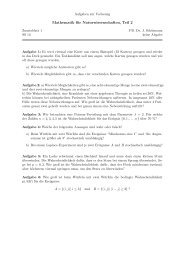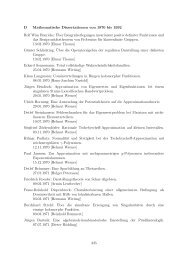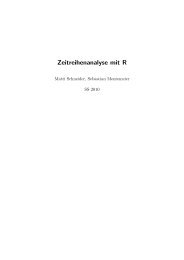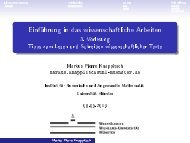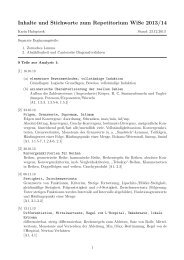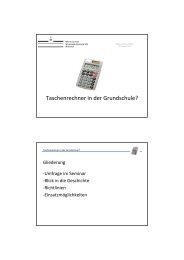Margulis Lemma
Margulis Lemma
Margulis Lemma
You also want an ePaper? Increase the reach of your titles
YUMPU automatically turns print PDFs into web optimized ePapers that Google loves.
STRUCTURE OF FUNDAMENTAL GROUPS 43<br />
not central in ˆN i one replaces it by [ˆN i , [ˆN i , ˆN i ]]. After finitely many similar steps<br />
this proves the claim.<br />
For each positive integer l put l · A i = {g l | g ∈ A i } ⊳ Γ i . We define l i = 2 ui as<br />
the maximal power of 2 such that there is an element in l i · A i which displaces ˆp i<br />
by at most ρ 0 . Thus, any element in L i := l i · A i displaces ˆp i by at least ρ 0 /2.<br />
After passing to a subsequence we may assume that ( ˆM i , Γ i , ˆp i ) converges to<br />
(Ŷ , Ĝ, ˆp ∞) and the action of L i converges to an action of some discrete abelian<br />
subgroup L ∞ ⊳ Ĝ. Finally we let ˆN ∞ ⊳ Ĝ denote the limit group of ˆN i . Let g i ∈ L i<br />
be an element which displaces ˆp i by at most ρ 0 . Combining d(gi k ˆp i, g k+1<br />
i ˆp i ) ≤ ρ 0<br />
with our choice of ρ 0 , see (23), gives that the sets {gi k ˆp i | k ∈ Z} converge to a<br />
discrete subset in the identity component of the limit orbit Ĝ0 ⋆ ˆp ∞ . Therefore,<br />
{g ∈ L ∞ | g ⋆ ˆp ∞ ∈ Ĝ0 ⋆ ˆp ∞ }<br />
is discrete and infinite. Let K ⊂ Ĝ denote the isotropy group of ˆp ∞. By Colding and<br />
Naber K is a Lie group and thus it only has finitely many connected components.<br />
Hence L ′ ∞ := L ∞ ∩Ĝ0 ⊳Ĝ is infinite as well. Since the abelian group L′ ∞ is a discrete<br />
subgroup of a connected Lie group, it is finitely generated.<br />
We choose a free abelian subgroup ˆL ⊂ L ′ ∞ of positive rank which is normalized<br />
by Ĝ such that the induced representation of Ĝ in ˆL ⊗ Z Q is irreducible. Notice that<br />
ˆL ⊂ L ∞ commutes with ˆN ∞ . Hence we can view this as a representation of Ĝ/ˆN ∞ .<br />
Recall that π 1 (M i )/N i<br />
∼ = Γi /ˆN i is boundedly represented. Let ĝ i1 , . . . , ĝ iβ ∈ Γ i<br />
denote the images of g i1 , . . . , g iβ . There is an epimorphism Γ i /ˆN i → Ĝ/ˆN ∞ induced<br />
by sending ĝ im to its limit element ĝ ∞m ∈ Ĝ for all large i. Thus, ˆL is also naturally<br />
endowed with a representation of Γ i /ˆN i .<br />
Let b 1 , . . . , b l ∈ ˆL ∼ = Z l be a basis. For large i there are unique elements h i (b j ) ∈<br />
L i which are close to b j , j = 1, . . . , k. We extend h i to a Z-linear map h i : ˆL → L i .<br />
We plan to prove that h i : ˆL → L i is equivariant for large i. For any given<br />
linear combination ∑ l<br />
α=1 z αb α (z j ∈ Z) we know that ∑ l<br />
α=1 z αh i (b α ) is the unique<br />
element in L i which is close to ∑ lα=1 z αb α for all large i.<br />
For each ĝ ∞m and each b j we have ĝ ∞m b j ĝ∞m −1 = ∑ lα=1 z αb α for z α ∈ Z (we<br />
(∑ l<br />
suppress the dependence on m and j). We have just seen that h i α=1 z )<br />
αb α is<br />
close to ĝ ∞m b j ĝ∞m −1 for all large i. On the other hand, ĝ im h i (b j )ĝ −1<br />
im ∈ L i is the<br />
unique element in L i close to ĝ ∞m b j ĝ∞m −1 for all large i.<br />
In summary, h i (ĝ ∞m b j ĝ∞m) −1 = ĝ im h i (b j )ĝ −1<br />
im for m = 1, . . . , β, j = 1, . . . , k and<br />
all large i. This shows that h i is equivariant with respect to the representation.<br />
Thus, h i (ˆL) is a normal subgroup of Γ i and the induced representation of F =<br />
π 1 (M i )/N i = Γ/ˆN i in h i (ˆL) ⊗ Z Q and is isomorphic to the one in h j (ˆL) ⊗ Z Q for all<br />
large i, j.<br />
There is a unique subgroup A ′ i of ˆN i such that h i (ˆL) has finite index in A ′ i and<br />
ˆN i /A ′ i is torsion free. Let N ih 0+1 ⊳ N i denote the inverse image of A ′ i ⊂ ˆN i = N i /H i .<br />
Clearly, the representation of π 1 (M i )/N i in (N ih0+1/H i ) ⊗ Z Q is isomorphic to<br />
the one in (N jh0+1/H j ) ⊗ Z Q for all large i, j – a contradiction to our choice of H i .<br />
Proof of the addendum. Thus, the sequence satisfies a) and b) but not the<br />
addendum. Recall that N i has a nilpotent basis of length ≤ n − dim(X). Therefore<br />
dim(X) = 1 and N i is a torsion free group of rank n−1. Since X is one-dimensional<br />
we deduce that G/N ∞ is virtually cyclic, that is, it contains a cyclic subgroup of


